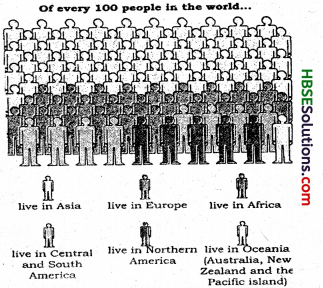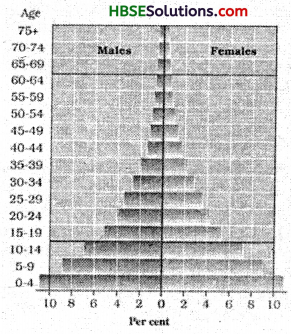Haryana State Board HBSE 8th Class Social Science Solutions Geography Chapter 6 Human Resource Textbook Exercise Questions and Answers.
Haryana Board 8th Class Social Science Solutions Geography Chapter 6 Human Resource
HBSE 8th Class Geography Human Resource Textbook Questions and Answers
Question 1.
Look at Fig. 6.1 and find out the continents which have the population:
(a) Only 5 percent
(b) Only 13 percent
(c) Only 1 percent
(d) Only 12 percent
Answer:
(a) North America
(b) Africa
(c) Oceania (Australia)
(d) Europe

Question 2.
Look at Fig. 6.2. below and find out of these countries how many are in Asia. Colour them on world map.

Answer:
The countries in Asia are : China, India, Indonesia, Pakistan, Bangladesh and Japan.
EXERCISES
Question 1.
Answer the following questions:
(i) Why are people considered a resource?
(ii) What are the causes for the uneven distribution of population in the world?
(iii) The world population has grown very rapidly. Why?
(iv) Discuss the role of any two factors influencing population change.
(v) What is meant by population composition?
(vi) What are population pyramids? How do they help in understanding about the population of a country?
Answer:
(i) People are considered a resource because it is the people who work on the natural resources of a country to produce wealth and raise standard of living.
(ii) Causes for the uneven distribution of population
(a) Geographical Factors:
→ Topography : People always prefer to live on plains rather than mountains and plateaus because these areas are suitable for farming, manufacturing and service activities. The Ganga plains are the most densely populated areas of the world while mountains like Andes, Alps and Himalayas are sparsely populated.
→ Climate: People usually avoid extreme climates that are very hot or very cold like Sahara desert, Polar regions of Russia, Canada and Antarctica.
→ Soil: Fertile soils provide suitable land for agriculture. Fertile plains such as Ganga and Brahmaputra in India, Hwang-Ho, Chang Jiang in China and the Nile in Egypt are densely populated.
→ Water: People prefer to live in the areas where fresh water is easily available. The river valleys of the world are densely populated while deserts have sparse population.
→ Minerals : Area with mineral deposits are more populated. Diamond mines of South Africa and discovery of oil in the Middle East lead to setting of people in 1 these areas.
![]()
(b) Socio-cultural and economic Factors
→ Social: Areas of better housing, education and health facilities are more densely populated e.g., Pune.
→ Cultural : Places with religion or cultured significance attract people. Varanasi, Jerusalem and Vatican City are some examples.
→ Economic : Industrial areas provide employment apportunities. Large number of people are attracted to these areas. Osaka in Japan and Mumbai in India are two densely populated areas.
(iii) The world population has grown very rapidly because of:
(а) Decrease in death rate due to :
- Increase food supplies
- Better medical facilities
(b) Birth rate still very high.
(iv) Population change refers to change in the number of people living during a specified period of time. Main factors influencing population change are:
- The difference between the birth rate and death rate (natural growth rate) is the main cause of population change.
- Migrations also bring about population change. Migration refers to the movement of people in and out of an area. People may move within a country or between countries.
(v) The different characteristics of a population in terms of age, sex, literacy level, health conditon, occupation and income level together form the composition of the population.
(vi) The distribution of various age groups in the population is shown by the age structure and male-female ratio diagram. This is called population pyramid.
The shape of the population pyramid of a country reveals two major details about the people age-group and sex-ratio. It also tells us how many dependents are there in a country.
Question 2.
Tick the correct answer:
(i) Which does the term population distribution refer to?
(a) How population in a specified Area changes over time.
(b) The number of people who die in relation to the number of people born in a specified area.
(c) The way in which people are spread across a given area.
Answer:
(c) The way in which people are spread across a given area.
(ii) Which are the three main factors that cause population change?
(a) Births, deaths and marriage
(b) Births, deaths and migration
(c) Births, deaths and life expectancy
Answer:
(b) Births, deaths and migration.
(iii) In 1999, the world population reached ________.
(а) 1 billion
(b) 3 billion
(c) 6 billion
Answer:
(c) 6 billion.
![]()
(iv) What is a population pyramid?
(a) a geographical presentation of the age, sex composition of a population.
(b) When the population density of an area is so high that people live in tall buildings.
(c) Pattern of population distribution in large urban areas.
Answer:
(c) 6 billion
Question 3.
Complete the sentences below using some of the following words.
sparsely, favourable, fallow, artificial, fertile, natural, extreme, densely
When people are attracted to an area it becomes ________ populated. Factors that influence this include ________ climate, good supplies of ________ resources and ________ land.
Answer:
densely, favourable, natural, fertile.
ACTIVITY
Question 4.
Discuss the characteristics of a society with “too many under 15s” and one with “too few under 15’s”.
Hint : need for schools, pension schemes, teachers, toys, wheel chairs, labour, supply, hospitals.
Answer:
People of different age groups have different requirements. If a society has too many under 15s; it will require more teachers, toys, schools as per the needs of children. Labour supply will be less.
If a society has too few under 15s, it implies it has more adult population which will require more pension schemes, hospitals, wheel chairs Labour supply will be more.
HBSE 8th Class Geography Human Resource Important Questions and Answers
Very Short Answer Type Questions
Question 1.
When did the Ministry of Human Resource Development establish? What was its aim?
Answer:
The Ministry of Human Resource Development was established in 1985. Its main aim was to improve people’s skills.
Question 2.
What do you understand by the pattern of population distribution?
Answer:
The way in which people are spread across the earth surface is known as the pattern of population distribution.
Question 3.
Which are the most crowded areas of the world?
Answer:
- South and South-East Asia
- Europe
- North-Eastern North America.
![]()
Short Answer Type Questions
Question 1.
Sixty percent of the world’s population stay in just 10 countries. Name any eight of them.
Answer:
- China
- India
- USA
- Indonesia
- Brazil
- Pakistan
- Bangladesh
- Russia
- Nigeria
- Japan.
Question 2.
What is the average density of population of the world? Which part of the world- have the highest density of population?
Answer:
The average density of population of the world is 45 persons per sq km. South central Asia has the highest density of population.
Question 3.
In the early 1970s, the world population was 3 billion. In 1999, the population doubled to 6 billion. What were the factors responsible for this growth?
Answer:
Factors responsible for this population growth were :
- Better food supplies
- Better medicines and
- Reduced Death Rate
- Number of births medical facilities remained fairly high.
Question 4.
Does emigration and immigration affect the population size of a country? Give example in support of your answer.
Answer:
Emigration and immigration do affect the population size of a country. Example: the population of United States of America and Austrilia increased due to immigration while Sudan has experienced a loss in population due to emigration.
![]()
Long Answer Type Questions
Question 1.
Explain how social, cultural and economise factors affect the distribution of population?
Answer:
Social factors: Area of better housing, education and health facilities are more densely populated, e.g., Pune, Bangalore, Chandigarh. Cultural factors : Places of religious or cultural signifi cance attract people. For example, Varanasi, Jerusalem and Vatican city.
Economic factors: Industrial areas provide employment opportunities, thus, attract large number of people. For example, Osaka, Mumbai.
Question 2.
Until the 1300s, the world’s population grew steadily but slowly. Give reasons.
Answer:
- Large number of babies were born, but they died early too.
- Lack of proper health facilities.
- Sufficient food was not available to masses.
- Farmers were not able to produce enough to meet the food requirements of all the people.
Question 3.
What is the general trend of international and internal (within a nation) migration?
Answer:
- The general trend of international migration is from less developed nations to the more developed nations in search of better employment opportunities.
- Within a nation, people move from the rural to urban areas in search of employment education and health facilities.
Question 4.
How does the population pyramid of a country in which both birth and death rates are high look? What do you conclude from such pyramid?
Answer:
The population pyramid of a country in which both birth and death rates are high, is broad at the base and rapidly narrows towards the top. This is because, although many children are born, a large percentage of them die in their infancy, relatively few become adults and there are very few old people.
Question 5.
How do soil and water affect the distribution of population?
Answer:
→ Soil: Fertile soil provides suitable land for agriculture. Fertile plains such as Ganga and Brahmaputra in India, the Nile in Egypt are densely populated.
→ Water : People prefer to live in the areas where sufficient amount of fresh water is available. The river valleys of the world are densely populated while deserts are sparsely populated.
![]()
Question 6.
How to topography and climate affect distribution of population?
Answer:
→ Topography : People prefer to live on plains rather than mountains and plateaus because plains are suitable for farming, manufacturing, transportation, etc. The Hwang Ho plains are densely populated while mountains like Andes, Alps, Himalayas are sparsely populated.
→ Climate : Regions of very hot and very cold climate like Sahara desert, Antarctica are sparsely populated.
Picture Based Questions
Look at the population pyramid shown in the adjoining picture. Answer the questions that follow:

Question 1.
To which country does it belong to?
Answer:
It belongs to Kenya.
Question 2.
Why is it broad at the base?
Answer:
This is broad at the base because many children are born.
Question 3.
Why does the population pyramid rapidly narrows towards the top
Answer:
The population pyramid rapidly narrows towards the top because though many children are born, a large percentage of them die in their infancy, relatively few become adults and there are very few old people.
Human Resource Class 8 HBSE Notes
- Human Resources: All human beings engaged in some useful activities represent the human resources.
- Pattern of Population Distribution: The way in which people are spread across the earth’s surface is known as the pattern of population distribution.
- Population Density : Population density is the number of people living in a unit area of the earth’s surface.
- Population Change : The population change refers to change in the number of people during a specific time.
- Migration : Migration is the movement of people in and out of an area.
- Life Expectancy: It is the number of years that an average person can expect to live.
- Birth Rate : The number of live births per 1000 people.
- Death Rate : The number of deaths per 1,000 people.